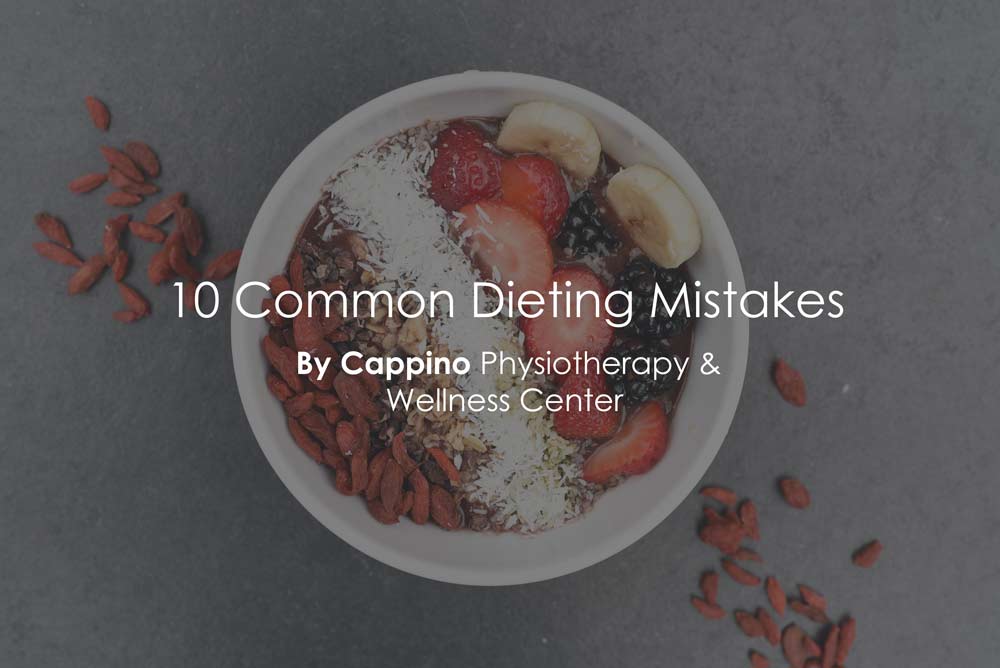10 Common Dieting Mistakes to Avoid
Nutrition Tips and Advice
For many, dieting is simply seen as “eating less and moving more”. However, there are many more aspects to pay attention to and these vary from setting a realistic weight loss goal to making informed food choices. You’re working hard to achieve your healthy weight goal so make sure that you’re not falling victim to these common dieting mistakes.
1. Unrealistic Goals
Aiming to lose 20 pounds within the first 2 weeks is setting yourself up for failure. You will feel discouraged when you don’t see the dream number on your scale. A realistic goal is vital to successful dieting. If you’re not sure what your goal should be, talk to a dietitian.
Tip: Accepting weight loss that misses the goal by a few pounds is healthier than perceiving your diet as a failure and then giving in and gaining the weight back.
2. Restricting Yourself Too Much
You might associate dieting with depriving yourself from many foods you love. But you are unlikely to comply with your diet on the long-term if you think you will never eat your favorite foods again! If you’re not sure on how to plan your diet, ask a dietitian.
Tip: Allow yourself a small amount of the foods you love every now and then, keeping in mind your main goal and moderation.
3. Eliminating Carbohydrates
Carbohydrates are a major macronutrient and one of your body’s primary source of energy. Still, there is a constant weight loss buzz that discourages eating them, and it is often many people’s first diet step. For an effective diet, include complex carbohydrates as they provide you with important vitamins, minerals and fiber. While maintaining the health of the digestive tract, fiber helps control your appetite, so it’s easier to keep weight in check.
Tip: The key is finding the right carbohydrates, not avoiding them all together. Include whole-wheat bread, beans, legumes, vegetables, fruits and limit refined carbohydrates such as white bread.
4. Skipping Meals
Skipping meals may seem like a quick way to cut down the calories, but you’re more likely to be hungry and overeat the rest of the day to compensate. Studies show people who eat breakfast every morning and follow a regular meal schedule are more likely to maintain a healthy weight.
Tip: Eat three meals a day with no more than 3 to 4 hours between each meal. Prepare and portion meals ahead to have quick access to healthy meals on a busy schedule.
5. Forgetting to Snack
Eating snacks throughout the day helps to control hunger, and consequently lose weight. Most people need to eat every three to four hours to avoid getting too hungry, which often leads to overeating. Dividing your calories into three meals and two or three snacks, instead of only three meals, can keep you well fueled for the day.
Tip: Include nutritious snacks when planning your meals and add them to your grocery list. What you keep in your cupboards is what you’ll snack on!
6. Serving Large Portions
It’s so easy to eat more than you need, but the good news is you have an accurate healthy portion measure with you already: your plate! Vegetables and fruit should cover half your plate, Proteins, such as meat, poultry or fish, should cover the quarter of your plate, Carbohydrates should cover the last quarter. For more accurate information on portion sizes refer to Canada’s Food Guide.
Tip: If these portions look small, try chewing your food slower – you might be surprised at what amount actually fills you up when you give your brain and stomach enough time to sync up and register that you’re full.
7. Forgetting Drinks Contain Calories Too
Many hidden calories are found in drinks. Sweetened beverages are the greatest contributor of added sugars in our diet, and the calories stack up without your knowing. It is essential to keep track of the calories you are consuming in your coffee, tea or juice and try to choose low-calorie alternatives.
Tip: Re-think your drink: Quench your thirst with water and flavour it with mint or lemon slices, try spices such as cinnamon to sweeten your tea and choose 100% pure fruit juice to reduce the added sugars and calories.
8. Overdoing Your Salads
Salad. The word itself sounds healthy: light, quick and easy to digest! Affix “salad” to anything and suddenly it is perceived as a healthy option. If your goal in ordering a salad from a restaurant is to eat healthy or low-calorie then you should read the nutritional information to keep track of your calories. Try to limit ingredients that increase the caloric content of your salads, and replace them with choices you can enjoy and that will keep you full longer.
Tip: Prepare your own salad dressing or reduce your favourite dressing by half, use low fat yogurt or greek yogurt for creaminess, choose low-fat cheese, and replace toppings such as croutons with a few almonds for a crunch.
9. Confusing Thirst with Hunger
It is common for people to confuse thirst for hunger. Knowing the difference between how it feels to be hungry and how it feels to be thirsty can help you control your diet, and avoid eating more than your body needs. Do not be tempted to reach for whatever food is in sight at the first sign of hunger.
Tip: To successfully identify whether the feeling is hunger or thirst: drink water the first time your brain tells you that you’re hungry. Wait 15 minutes before you decide. If you were truly hungry, that feeling of wanting to eat something won’t dissipate. But if you were in fact thirsty, then you’ll feel satisfied.
10. Thinking Fat-Free is Calorie-Free
While trans-fat free foods are encouraged, foods labelled as “Low-Fat” or “Fat-Free” may contain more calories and additives than the original product. Food makers use ingredients such as sugar, flour, thickeners, and salt to improve the flavour and texture of the product. Consequently, you will end up consuming more calories and other nutrients such as sodium that you want to limit in your diet.
Tip: Fat-free foods aren’t calorie-free foods. Look at the Nutrition Facts panel on the food label. Many have just as many calories as the original versions, and a few have even more.
Post by DANA AL-KAHWAJI, BSc, RD

